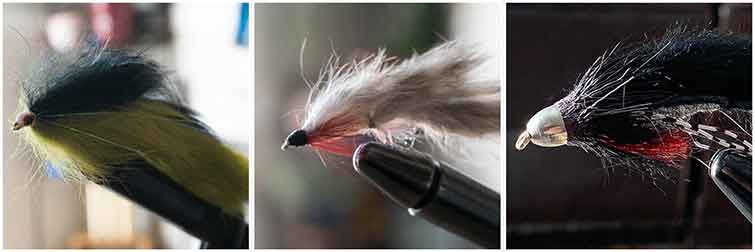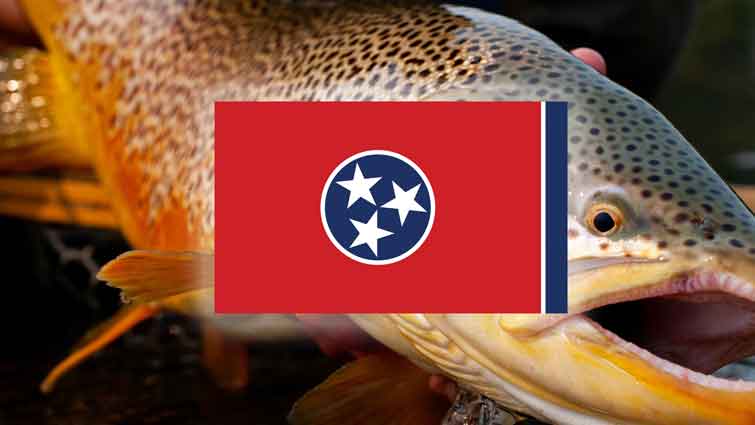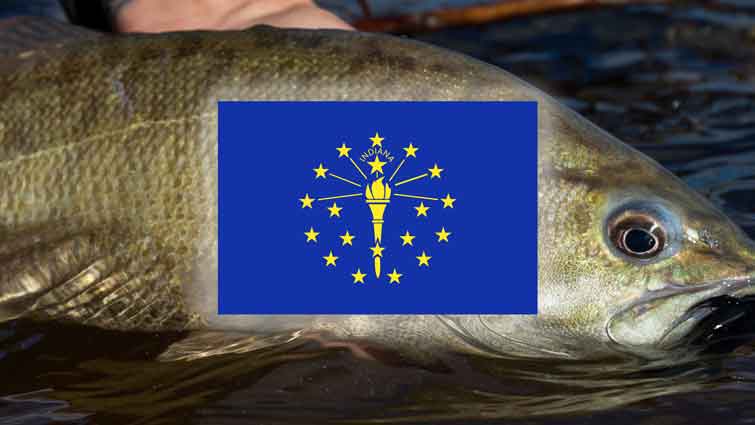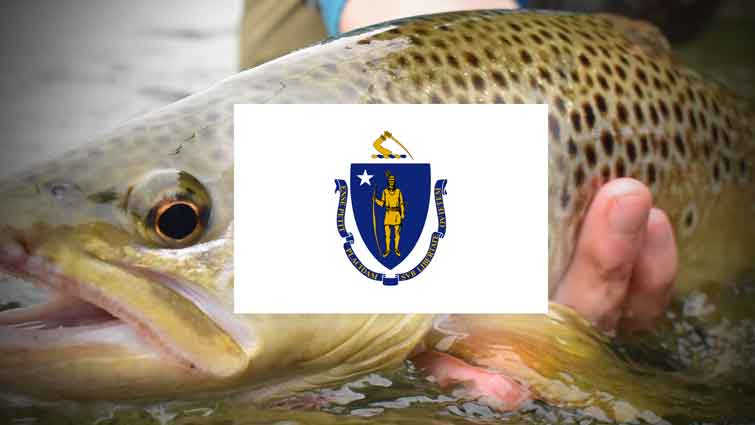When you think about prime fly fishing spots in the United States, Tennessee might not be the first state that comes to mind, but for anglers, Tennessee is a hot spot for fly fishing. Tennessee's waters provide ample opportunity to catch trout because of their tremendous number of rivers, streams, and tailwaters, which are home to the hundreds of thousands of trout stocked yearly by the Tennessee Wildlife Resources Agency.
Here are some of the top places to fly fish in Tennessee:
- Abrams Creek
- Cane Creek
- Caney Fork River
- Chickamauga Reservoir
- Citico Creek
- Clinch River
- Collins River
- Duck River
- Elk River
- Great Smoky Mountains National Park and more

Because Tennessee is located in the southeastern United States, the state has a climate conducive to year-round fly fishing. In the spring, anglers can target spawning trout, and in the fall, they can take advantage of the cooler temperatures to fish for trout feeding heavily in preparation for winter. Let's look at the state's top 21 spots for fly fishing success.
Best Fly Fishing locations in Tennessee
Most of Tennessee's freshwater streams, rivers, and lakes are managed by the Tennessee Wildlife Resources Agency (TWRA). The TWRA stocks trout in many of these waters and regulates fishing seasons and creel limits.

1. Abrams Creek
Abrams Creek is a stream in Blount County, Tennessee. Its source is in Cades Cove, and it is a tributary of the Little Tennessee River. It was named after Chilhowee Cherokee leader Old Abraham ("Abram").
This small stream is located in Great Smoky Mountains National Park and is considered one of the best fly fishing streams in the park. Abrams Creek is home to rainbow, brook, and brown trout. The stream is easily accessible, and anglers can find good fishing opportunities upstream from the confluence with Rock Creek.

Recommended Fly Patterns for Abrams Creek, Tennessee:
- CDC Caddis Emerger - Olive - Size 16
- Copper John Beadhead- Red - Size 18
- Zebra Midge Curved Silver - Tungsten - Barbless - Size 18

2. Cane Creek
Cane Creek Lake is a reservoir in Putnam County, Tennessee, United States, located less than 2.6 miles from Cookeville. Fishermen will encounter a variety of species, including:
- Bullhead
- Redear sunfish
- Panfish
- Blue catfish
- Flathead catfish
- Rainbow trout, and more.
Cane Creek Falls, located near Spencer, Tennessee, above the confluence of Cane Creek and Rockhouse Creek, is an 85-foot (26 m) plunge waterfall. The falls may be viewed from the Gorge Trail and Cane Creek Gorge's base, which can be accessed via the Cable Trail.

Recommended Fly Patterns the Cane Creek, Tennessee:
- Elk Hair Caddis CDC- TAN - Size 16
- Brassy - Size 18
- Flashback Pheasant Tail, Beadhead Gold - Size 18

3. Caney Fork River
The Caney Fork River is a river in central Tennessee that drains part of the southwestern Cumberland Plateau and southeastern Highland Rim regions. It is a tributary of the Cumberland River and part of the Cumberland, Ohio, and Mississippi basins.
The river has a length of 143 miles (230 km) and drains 1,771 square miles (4,590 km2) in eleven counties. Monterey, Baxter, Sparta, Smithville, McMinnville, Altamont, Spencer, and Gordonsville are some of the settlements that entirely or partly derive their water from the Caney Fork river.

Recommended Fly Patterns for Caney Fork River, Tennessee:

4. Chickamauga Reservoir
The Chickamauga Dam is a dam on the Tennessee River in Chattanooga, Tennessee, United States. The dam was built during the Great Depression by the Tennessee Valley Authority as part of a New Deal project to improve navigation and bring flood control and economic development to the Tennessee Valley.
This reservoir has a more riverine aspect in the upper half, while the mid to lower section is more sluggish and features considerable embayments. Largemouth bass, smallmouth bass, striped bass, bluegill, redear sunfish, walleye, sauger, and catfish are all popular game fish found in Chickamauga.

Recommended Fly Patterns for the Chickamauga Reservoir, Tennessee:

5. Citico Creek
Citico Creek Wilderness is a 16,226-acre (66 km2) wilderness area in Tennessee's Cherokee National Forest. The entire upper drainage of Citico Creek, which comprises the north and south forks and at least eight tributaries, is included within the Citico Creek wilderness.
The upper stretches of Citico Creek are rich in wild trout, although the Tennessee Wildlife Agency regularly stocks it from Little Citico Creek to the Citico Creek Wilderness boundary. The stream's brown and rainbow trout, smallmouth bass, and catfish can be fished all year round.
The Warden Fields trailhead has a parking lot for access to Citico Creek. To fish along the bridge area, walk south on Warden Fields Trail and then east on Pine Ridge Trail until you reach the junction.

Recommended Fly Patterns for Citico Creek, Tennessee:

6. Clinch River
The Clinch River, which extends for more than 300 miles (480 km) through the Great Appalachian Valley in Virginia and Tennessee, gathers numerous tributaries before merging with the Tennessee River near Kingston, Tennessee.
The Clinch is home to rainbow trout, brown trout, and brook trout. Most of the fish caught will be strong, wild, high-quality fish, ranging from 14 to 16 inches. It isn't unusual for an experienced angler to land half a dozen big fish over 18 inches during the sulfur emergence in spring.
During May through June, decent mayflies hatch regularly, and a routine midge hatch is typical on the Clinch throughout the year.

Recommended Fly Patterns for the Clinch River, Tennessee:

7. Collins River
The Collins River is a tributary of the Caney Fork River, approximately 72 miles (116 km) long, in middle Tennessee in the United States. Via the Caney Fork, Cumberland, Ohio, and Mississippi rivers, it is part of the watershed of the Mississippi, draining an area of 276 square miles (715 km2).
The Collins River flows through Grundy and Warren counties, as well as McMinnville, Altamont, Gruetli-Laager, and Beersheba Springs. The Collins River is suitable for fly-fishing and canoeing, and it is stocked regularly with trout by the Tennessee Wildlife Resources Agency.

Recommended Fly Patterns for the Collins River, Tennessee:
- Comparadun PMD - Size 16
- Hare's Ear - Natural - Size 18
- The Frenchie Flashback - Tungsten - Barbless - Size 12

8. Duck River
The Duck River, which is 284 miles (457 km) long, runs entirely within the state of Tennessee. The Duck River is home to over 50 species of freshwater mussels and 151 species of fish, making it North America's most biodiverse river.
The Duck River drains a significant portion of Middle Tennessee. The Duck River flows through Western Kentucky, forming the Western Highland Rim and connecting to several major tributaries, notably the Piney River.

Recommended Fly Patterns for the Duck River Tennessee Fly Fishing
- Royal Wolf - Size 12
- Poppers - Size 6
- Slump Buster with Cone - Black - Size 6

9. Elk River
The Elk River is a river in the U.S. states of Tennessee and Alabama that is part of the Tennessee River system. The river has a length of about 195 miles (314 km). The Elk River rises in Burroughs Cove near Elkhead, Grundy County, Tennessee.
The Elk River begins on the northwest slopes of Peak Mountain and flows west to Banner Elk before turning south toward Elk Park. For the most part, it runs through a deep canyon. Before entering Tennessee, the river passes over "Big Falls" (also known as "Elk Falls"), which is a locally known attraction with a drop of approximately 60 feet.
The Elk River downstream of Tims Ford Dam in south-central Tennessee is home to a prized trout fishery that provides outstanding wade and bank fly fishing.

Recommended Fly Patterns for the Elk River, Tennessee:
- Caddis Larva - Beadhead - Green - Size 16
- Perdigon Pearl - Tungsten -Barbless - Size 14
- Zebra Midge Curved Red - Tungsten - Barbless - Size 18

10. Great Smoky Mountains National Park
The Great Smoky Mountains National Park has about 2,900 miles of streams within its boundaries and is home to one of the last wild trout habitats in the eastern United States. Trout populations can thrive in around 20% of the park's rivers. The park offers a wide range of fishing opportunities, from remote headwater brook trout streams to big, cool water smallmouth bass streams.
Most waterways stay full or near-capacity with fish and provide an excellent chance to catch them at any time of year. The park is open year-round and allows fishing in all streams from 30 minutes before official sunrise to 30 minutes after official sunset.

Recommended Fly Patterns for the Great Smoky Mountains National Park, Tennessee:

11. Hiwassee River
The Hiwassee River is about 147 miles (237 km) long, with its source on the north slope of Rocky Mountain in Towns County in the northern section of Georgia. It flows north into North Carolina before turning west into Tennessee, emptying into the Tennessee River a few miles west of State Route 58 in Meigs County, Tennessee.
The Hiwassee River is in the extreme southeast corner of Tennessee and has long been a favorite destination for fly anglers from across the nation. The dry fly fishing possibilities on the Hiwassee are legendary, occurring all year.

Recommended Fly Patterns for the Hiwassee River, Tennessee:
- RS2 - Olive - Size 20
- Glo Bug Red Dot (Egg) - Orange) - Size 10
- Kaufmanns Stimulators - Orange - Size 16

12. Holston River
The Holston River is a 216-mile (346 km) river that runs from Kingsport, Tennessee, to Knoxville, Tennessee. It is part of a larger drainage basin that drains much of northeastern Tennessee, southwestern Virginia, and western North Carolina's mountainous regions.
The confluence of the Holston River and the French Broad River at Knoxville marks the start of the Tennessee River.

Recommended Fly Patterns for the Holston River, Tennessee:
- Flashback Pheasant Tail-Beadhead Gold - Size 16
- Zebra Midge Curved Black - Tungsten - Barbless - Size 18
- Matuka Sculpin Olive - Size 4

13. Hurricane Creek
Hurricane Creek, a stream running through La Vergne, boasts numerous species. Largemouth bass, Smallmouth bass, and Channel catfish are the most common types caught here. The city of La Vergne is located in northern Rutherford County, south of Nashville.
It is bordered by the Antioch community of Nashville on the northwest, Smyrna on the southeast, and Percy Priest Lake to the northeast.

Recommended Fly Patterns for the Hurricane Creek, Tennessee:

14. Little River
The Little River in the Great Smoky Mountains National Park is ideal for fly fishing for wild rainbow trout and surprisingly large brown trout in magnificent mountain scenery. Inside the park, the Little River is more like three rivers with an East, Middle, and West prong (branch) that caters to a wide range of fishing styles.
To fish within the Great Smoky Mountains National Park, you'll need a Tennessee or North Carolina fishing license. Only artificial flies or lures with a single hook are permitted when fishing the Little River.

Recommended Fly Patterns for the Little River, Tennessee:

15. Melton Hill Reservoir
Melton Hill Reservoir is a lake on the Clinch River in Oak Ridge, Tennessee. It covers 5,690 surface acres and is situated near Oak Ridge. The north shoreline is largely owned by the United States Department of Energy, while the opposing shoreline is privately held.
The reservoir is narrow and riverine in the west, with a few small coves on the main navigation channel. Melton Hill is a cool water reservoir with modest productivity. Cold water released from the dam has a detrimental impact on warm water fish species like Largemouth Bass and Bluegill, resulting in slow growth and limited reproduction.
The water temperatures guarantee that the dissolved oxygen levels are adequate all summer for Smallmouth Bass, Striped Bass, and Musky.

Recommended Fly Patterns for the Melton Hill Reservoir, Tennessee:

16. Obey River
The Obey River is a 47.8-mile tributary of the Cumberland River in Tennessee. It joins the Cumberland River near Celina, which is generally regarded as the head of navigation on the river. The Obey is confined by the U.S. Army Corps of Engineers Dale Hollow Reservoir for almost seven miles, where it houses a fish hatchery operated by the federal government.
The Obey is fed cold water that runs from Dale Hollow, prime conditions and one of the reasons the river is loaded with trout. The West Fork of the Obey River is a waterway in Cookeville. The most popular fish caught here are Largemouth bass, Channel catfish, and Black crappie.

Recommended Fly Patterns for the Obey River, Tennessee:
- Flashback Hare's Ear-Beadhead-Natural - Size 18
- Prince Nymph Jigged Tungsten - Size 12
- Copper John Beadhead- Red - Size 18

17. Reelfoot Lake Fly Fishing
Reelfoot Lake is a small natural lake in the northwestern part of Tennessee, in Lake and Obion Counties. Much of it is marshy with bayou-like ditches (some natural, some artificial) connecting bigger open bodies of water known as basins, the largest of which is Blue Basin.

Recommended Fly Patterns for the Reelfoot Lake, Tennessee:
- The Clouser Minnow - Multiple Colors - Size 6-8
- Slump Buster with Cone - Black - Size 8
- Muddler Minnow - Size 6

18. South Holston River
The South Holston River is one of the most picturesque and popular trout streams in eastern Tennessee, and it's also one of the best tailwaters in the southeast. All of the brown trout in the South Holston Tailwater are naturally reproducing wild fish, which is extremely unusual for a tailwater fishery anywhere.

Recommended Fly Patterns for the South Holston River, Tennessee:
- Zebra Midge Curved Red - Tungsten - Barbless - Size 18
- San Juan Worm - Size 12
- Trophy Dungeon - Black - Size 8

19. Tellico River
The Tellico River is a tributary of the Little Tennessee River in western North Carolina and eastern Tennessee. It originates in the westernmost slopes of North Carolina before flowing through Monroe County, Tennessee, and joining the Little Tennessee River beneath the Tellico Reservoir with a length of 52.8 miles (85 km).
The Tellico River and its major tributaries are well-known for their brown, rainbow, and brook trout fishing.

Recommended Fly Patterns for the Tellico River, Tennessee:

20. Watauga River
The Watauga River originates from a spring near the base of Peak Mountain in Linville Gap, Avery County, North Carolina. The source of the spring is on the western side of the Tennessee Valley Divide, which here coincides with the Eastern Continental Divide.
The Watauga eventually drains into the Gulf of Mexico and is home to several species, including rainbow trout, brown trout, and striped bass. Along the way, it has several major tributaries that provide good fly fishing opportunities, most notably the South Fork of the Holston River.

Recommended Fly Patterns for the Watauga River, Tennessee:
- Zebra Midge Curved Silver - Tungsten - Barbless - Size 18
- Adams - Size 14
- Flashback Pheasant Tail-Beadhead Gold - Size 18

21. West Prong Stream
The Little Pigeon River's West Prong is one of the finest trout streams in the Great Smoky Mountains National Park. It runs adjacent to park road #441, which cuts through the park from Tennessee to North Carolina from near the Chimney Top Trailhead to Gatlinburg.
The West Prong of the Little Pigeon River is a mid-sized freestone stream teeming with wild rainbow and brook trout. There is no stocking here, so you may notice that the fish are more skittish than normal, providing a challenge to even the most expert anglers.

Recommended Fly Patterns for the West Prong Stream, Tennessee:
- RS2 Emerger - Gray - Size 20
- Hare's Ear - Natural - Size 18
- Rainbow Warrior Jigged Tungsten - Size 18
What Gear do I need to Fly Fish in Tennessee?
Fly fishing in Tennessee can be a great experience, but you need to make sure you have the right gear. During the summer months, clothing with UV protection is suggested. Rainwear, sunglasses, a hat or cap to protect the head, and sunblock are ideal at all times.
Tennessee fishing requires all of the basic fly fishing gear, including a rod, reel, line, tippet, and flies. Opt for a 9-foot, 5-weight rod for most small to medium-sized streams. If you are fishing for larger fish or in larger rivers, you may want to consider a heavier rod.
Additional Facts about Fly Fishing in Tennessee
Is Tennessee good for fly fishing?
Tennessee is an attractive place for anglers because it has a wide range of freshwater fly fishing possibilities across the state. Tennessee contains more than 22,000 miles of streams, 29 major reservoirs, and at least 315 distinct species of fish.
Is Tennessee good for trout fishing?
Tennessee is great for trout fishing because of its high concentration of wild trout. The Appalachian Mountain range in East Tennessee contains nearly 845 miles of stream with wild Brook, Rainbow, and Brown trout.
Is there a trout season in Tennessee?
The catch-and-release season in Tennessee is Oct. 1 through Feb. 28. From March 1 through Sept. 30, a trout creel limit of 7 fish of all species combined, and only two brown trout are permitted.
Can you fly fish the Tennessee River?
You can fly fish on the Tennessee River. Before the water warms up in the spring, the TWRA puts a stock of rainbow trout in the river in February, March, and April. This creek is ideal for wading and catching a variety of species, including trout, largemouth bass, smallmouth bass, bluegill, rock bass, and redear sunfish.
Tennessee has a lot to offer when it comes to fly fishing. With so many different rivers and streams, you're sure to find the perfect spot to cast your line. Thanks to frequent stockings, you can find trout all year round. And with a variety of other fish species in the state, you can always try your hand at something new. So grab your gear and head to Tennessee for some great fly fishing adventures.







2 comments
英文小麥
This is wonderful as the fly fisher’s guide to Tennesse has long since been out of print. Thank you for this! :)
This is wonderful as the fly fisher’s guide to Tennesse has long since been out of print. Thank you for this! :)
英文小麥
This is wonderful as the fly fisher’s guide to Tennesse has long since been out of print. Thank you for this! :)
This is wonderful as the fly fisher’s guide to Tennesse has long since been out of print. Thank you for this! :)